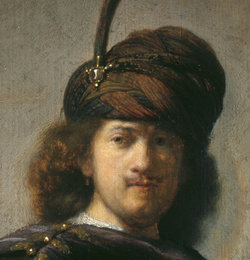Rembrandt
dal 14/10/2008 al 5/1/2009
Segnalato da
14/10/2008
Rembrandt
Prado Museum, Madrid
An exhibition that will allow the public to see more of the work of this remarkable artist. It includes around 35 paintings and 5 prints loaned from leading European and American museums and will focus on the subject of Rembrandt as a narrative painter. Although the artist was a great portrait and landscape painter, his activities as a history painter reveal particularly clearly the way in which his art continued the tradition of european Renaissance painting, while also allowing us to appreciate its originality.

Rembrandt (1606-1669) is one of the most personal painters in the entire history of European art. From his beginnings in Leiden to his death in Amsterdam, his painting is a constant quest for representing human emotions as incisively and movingly as possible. This exhibition focuses on his biblical and historical paintings. On the scale of values of Rembrandt and his contemporaries, these were the most important themes a painter could address. They were also his best vehicle for showing how people reacted to dramatic situations and, accordingly, for exploring the human condition.
The exhibition features works from all the periods in Rembrandt’s career. In his early paintings, the gestures of the human figures are extroverted and their gaze is often mocking and jocular. In his mature works, the emotions are more suppressed and the emphasis is on their mental energy.
Rembrandt was familiar with the history of European painting through his huge print collection and the Amsterdam art market. Along with works by Rembrandt, the exhibition includes a few paintings by other artists, all from the Museo del Prado collection. The purpose of these works is to help viewers understand the Dutch painter. Some represent the aesthetic model that guided the painter or to which he reacted. Others are works by contemporaries whose difference from Rembrandt helps comprehend his particular aesthetic. Rembrandt’s art is firmly rooted in the European pictorial tradition. However, his attitude towards this tradition is critical: very few artists have been so determined to change it or have done so in such a radical manner.
Rembrandt (1606-1669) is one of the most personal painters in the entire history of European art. From his beginnings in Leiden to his death in Amsterdam, his painting is a constant quest for representing human emotions as incisively and movingly as possible. This exhibition focuses on his biblical and historical paintings. On the scale of values of Rembrandt and his contemporaries, these were the most important themes a painter could address. They were also his best vehicle for showing how people reacted to dramatic situations and, accordingly, for exploring the human condition.
The exhibition features works from all the periods in Rembrandt’s career. In his early paintings, the gestures of the human figures are extroverted and their gaze is often mocking and jocular. In his mature works, the emotions are more suppressed and the emphasis is on their mental energy.
Rembrandt was familiar with the history of European painting through his huge print collection and the Amsterdam art market. Along with works by Rembrandt, the exhibition includes a few paintings by other artists, all from the Museo del Prado collection. The purpose of these works is to help viewers understand the Dutch painter. Some represent the aesthetic model that guided the painter or to which he reacted. Others are works by contemporaries whose difference from Rembrandt helps comprehend his particular aesthetic. Rembrandt’s art is firmly rooted in the European pictorial tradition. However, his attitude towards this tradition is critical: very few artists have been so determined to change it or have done so in such a radical manner.
Rembrandt’s formative period began in Leiden in 1620 and ended when he moved to Amsterdam around 1631. By then he was a successful painter who had taken on his first pupils. There is no single style that characterises Rembrandt’s art during those years, but rather a variety of languages through which the painter sought to express the feelings of the main figures of his compositions.
A few of Rembrandt’s works from the late 1620s show the influence of Rubens (1577-1640), by then the most famous artist in Europe whose oeuvre he was familiar with chiefly through engravings. For over a decade, until approximately 1645, Rubens provided Rembrandt with both an artistic and a professional model to imitate, which spurred his ambition to become a great painter.
Information, reservations and pre-booked tickets 902 10 70 77/ Tickets online
Prado Museum
Paseo del Prado, Madrid
Ehibition Opening Times
Tuesdays to Sundays, 9am to 8pm
24 and 31 December 2008, and 6 January 2009
Standard ticket: 8 €



